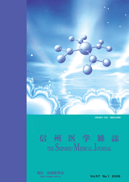Volume 63, Issue 2
Displaying 1-12 of 12 articles from this issue
- |<
- <
- 1
- >
- >|
Foreword
-
2015 Volume 63 Issue 2 Pages 83-84
Published: April 10, 2015
Released on J-STAGE: April 28, 2015
Download PDF (505K)
Review
-
2015 Volume 63 Issue 2 Pages 85-90
Published: April 10, 2015
Released on J-STAGE: April 28, 2015
Download PDF (1112K)
Original
-
2015 Volume 63 Issue 2 Pages 91-101
Published: April 10, 2015
Released on J-STAGE: April 28, 2015
Download PDF (868K)
Case Report
-
2015 Volume 63 Issue 2 Pages 103-108
Published: April 10, 2015
Released on J-STAGE: April 28, 2015
Download PDF (813K)
Current Topics
-
2015 Volume 63 Issue 2 Pages 109-111
Published: April 10, 2015
Released on J-STAGE: April 28, 2015
Download PDF (589K)
Round the World
-
2015 Volume 63 Issue 2 Pages 112
Published: April 10, 2015
Released on J-STAGE: April 28, 2015
Download PDF (168K)
My Choice of Speciality
-
2015 Volume 63 Issue 2 Pages 113
Published: April 10, 2015
Released on J-STAGE: April 28, 2015
Download PDF (376K)
Book Review by Author
-
2015 Volume 63 Issue 2 Pages 114
Published: April 10, 2015
Released on J-STAGE: April 28, 2015
Download PDF (402K)
What’s New? -The Latest from the Labs
-
2015 Volume 63 Issue 2 Pages 115
Published: April 10, 2015
Released on J-STAGE: April 28, 2015
Download PDF (787K) -
2015 Volume 63 Issue 2 Pages 116
Published: April 10, 2015
Released on J-STAGE: April 28, 2015
Download PDF (585K)
Abstract of Meetings
-
2015 Volume 63 Issue 2 Pages 117-121
Published: April 10, 2015
Released on J-STAGE: April 28, 2015
Download PDF (727K) -
2015 Volume 63 Issue 2 Pages 123-126
Published: April 10, 2015
Released on J-STAGE: April 28, 2015
Download PDF (540K)
- |<
- <
- 1
- >
- >|
